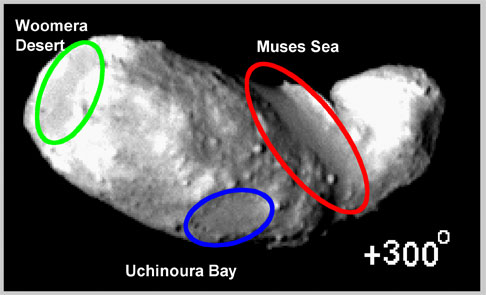SPACE PROBE NEWS Dawn Mars Itokawa Hayabusa
Dawn's Fleeting Fling With Mars

NASA's Dawn spacecraft swept past Mars on February 17, 2009, en route to Vesta and Ceres.
NASA / JPL

Mars does more than simply give Dawn a swift kick onward — it provides a handy calibration target for the craft's three scientific instruments: a visible-light camera, a visible and infrared mapping spectrometer, and a gamma-ray and neutron spectrometer nicknamed GRaND. (A press release about GRaND's activities is here.)
Because Dawn's approach path is on the dark side of Mars, the best tourist snapshots will come right after the flyby. (For a complete timeline of what happens when, read the interesting and informative online blog written by project manager Marc Raymond.)
But don't expect to see images beamed to Earth right away. To pan across the planet's amazing ocher plains, eons-old craters, and other features, Dawn has had to pivot away from its alignment with Earth. It'll return to its normal cruise attitude and reestablish high-rate communication in a couple of days, when the pretty pictures will start streaming home.
Then, on February 20th, Dawn swings back to view Mars one more time. The planet will be distant and receding, but it'll give flight controllers a view similar to how Vesta will appear when the spacecraft nears Vesta in 2011. It reaches Ceres in 2015.
www.skyandtelescope.com/news/39761122.html
The song Coming Home on a Wing and a Prayer, written in 1943, tells the saga of warplane damaged so badly that it was barely able to limp back to base.

A depiction of Hayabusa's touchdown on the asteroid 25143 Itokawa in November 2005.
Akihiro Ikeshita / JAXA

JAXA's announcement didn't provide many details. The spacecraft had been coasting toward Earth since November 2007, but it need to increase it speed by 900 miles per hour (400 meter per second) in order to complete its return to Earth in June 2010.
If and when that occurs, Hayabusa (which means "falcon") should eject a sealed capsule designed to parachute safely to the ground. Only then will JAXA engineers know for sure whether any bits of Itokawa lie waiting inside.

When it landed on the asteroid, the craft was supposed to fire a small spherical projectile into the surface in order to drive debris up into a collection chamber. But inexplicably the firing mechanism wasn't activated during its half hour on the surface. No bullet, no sample. Conceivably (fingers crossed), a few particles of dust ended up in the capsule anyway.

But let's not get too optimistic. Hayabusa still has a long road back. Although three of its four engines are still functional, JAXA engineers hope to power the craft for the next 13 months using only one of them — and it's already logged 31,000 hours of operation. As the announcement states, "We are continuing to pay careful attention to our onboard equipment and are doing our utmost to operate [the craft] with the greatest care."
Godspeed, Hayabusa!

www.skyandtelescope.com/news/39196417.html
 Earth's magnetic field:
Earth's magnetic field:

0 Comments:
Post a Comment
<< Home